Can You Promote a Mobile App Store Page on AdWords?
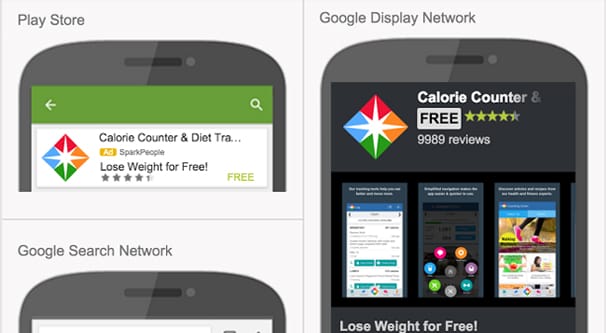
These days, it seems like everyone has an app or two. Bands have apps to monitor tours and shows. Restaurants use apps for their loyalty programs instead of cards they have to print out in plastic. Grocery stores use apps to replace both loyalty programs and coupon mailers. That doesn’t even scratch the surface of all of the stand-alone task apps and games out there.
Does Google allow you to promote apps through AdWords? Of course. You can drive traffic from AdWords to both the iTunes/Apple App Store and to the Google Play Store. Heck, you can even drive traffic to the Amazon App Store if you want. You can also drive traffic to your own website where a landing page can send users to the appropriate storefront.
Frankly, it would be insane of Google to not allow this kind of advertisement. Apps are a multi-billion-dollar industry at this point. Of course Google wants their slice of the pie, and by god is it a big one.
Standard Ads
As you might expect, Google allows standard ads with the app install goal objective in AdWords. These ads come in a few possible forms.
First up you have app install ads on both the search and display networks. These are the most like traditional Google ads. They show up in Google search results and on websites that are using AdSense to monetize.
App install ads in this location can include the icon for the app, the description of the app, and the app store rating. All it can do I slink to an app store. If you want to link to a landing page, you can’t use an app install ad, you have to use a regular website view ad. Search and Display ads can show up both as interstitials or as banner ads, which is pretty typical of AdWords ads.
The second type of app install ad is one specifically on Google Play. You can promote your app on the Google Play store, and it will show up as one of the recommended or sponsored listings. This shows the app icon, app name, name of the developer, your app rating, and some custom text. The caveat, of course, is that it only shows up on the Google Play store and can only link to a Google Play store listing. You can’t advertise the Apple version here, or an Amazon version, or a stand-alone version.
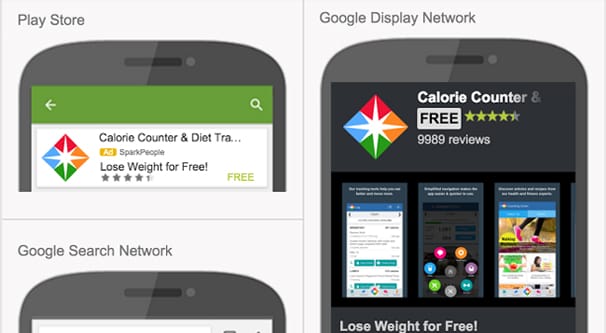
That’s all reasonable, of course. There’s no reason why someone would be browsing the Google Play store when their device can’t run any of those app versions. Google just wants to keep it all in the family.
The third kind of app install ad is a video ad on the display network. These ads can include a video (hosted on YouTube), as well as text, an app icon, app store text, and store rating. It can show on display network sites, as well as on YouTube videos that have ads enabled. This third kind of app can send users to your app install page directly from YouTube, or they can send people to the store page instead.
There’s one quirk about this kind of ad, and that’s video autoplay. Since videos can be pretty large, Google doesn’t autoplay the video for the ad in all circumstances. The video plays automatically only if the user is connected via a WiFi internet connection. If the user is using 3G, 4G, LTE, or another cell service for their data, Google doesn’t autoplay the video and instead makes the user tap to play it. This helps ensure ads aren’t devouring data limits, which hurts usability.
The fourth form of app install ad is the TrueView app install ad. These are in-stream video ads that include your app icon and associated information. AdWords is fully capable of making a video of their own for your app if you don’t make one yourself, but it’s almost always better to make one yourself so it’s customized to your app and your audience. These ads can advertise an iOS app and allows the user to download straight from the ad, without referring to a store page at all. Essentially, you’re just linking the destination of the ad to the download for the app file.
Universal App Campaigns
There’s another way you can create ads for apps with AdWords, and these are called Universal App Campaigns. A universal app campaign is a little different than a normal ad.
Unlike normal AdWords ads, you don’t make specific ads for your universal app campaign. You don’t have to deal with any of the fiddly individual copy and optimization techniques; you basically just create the campaign and let it run automatically.
What Google does is creates your ad text from assets in your store listing. You have to provide some text and your budget information, and if necessary, specify the languages and locations for your ads. From there, Google runs it all through their machine learning optimization, and will iterate on your ads based on their performance. Ideally, this makes your ads more and more likely to gain conversions the longer they run. It’s sort of like split testing, except you’re not doing any of the work.
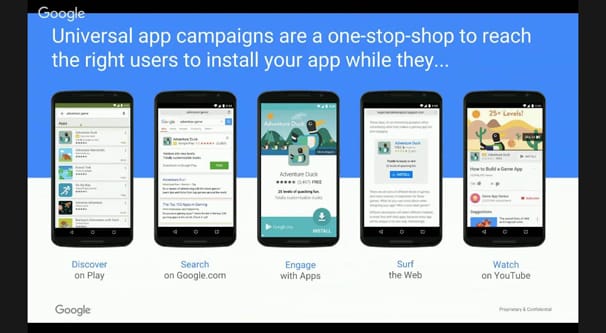
Universal ads can show up all over the place. They show up in the Google search network, of course, both in Google search and in their network of search partners. They can show up in the Google Play store as sponsored listings, in the search results, the “related apps” boxes, and in the suggested apps boxes. They can show up on YouTube, both as on-video ads and as ads in the recommended videos listing. They can show up in the Google display network, in Gmail, within other apps that use Google’s ad system to monetize, and on mobile sites using Google’s advertising.
Additionally, you can tell the universal campaign to optimize for one of three actions. The first action is, of course, getting more people to install the app. The second action is getting people to take some kind of action within your app, like buying a premium currency or upgrading to a paid plan for the service app. The third is for optimizing action value; getting people to buy more expensive packages or whatever your app needs.
Google generally prefers if everyone uses the universal app campaign function, though you don’t have to. If you’re trying to promote your app via a landing page, if you want to promote an iOS app or an app on the Amazon store, or some other non-standard configuration, you won’t be able to use the universal campaigns. Well, apps in the iTunes app store are able to use the campaign format, but are more limited because they can’t use Play Store ad placement and other Google/Android-specific ad formatting.
App Ad Requirements
If you’re running ads for your app through AdWords, you’re going to need to make sure your app complies with all of the AdWords policies. Google has a bunch of different reasons why they commonly disapprove apps from their ads systems, even if the app is allowed to run on the Google Play store. You don’t need to have an Android version of the app to run ads on AdWords; you can advertise a link to the Apple App Store just fine.
First up, your app text – in the store page – needs to comply with the AdWords advertising policies. There’s a lot to these policies, so make sure you read over them before you try to advertise. The reason for this is that Google can make ad copy out of the description you use for your app, so if your description in some way violates ad policies without violating store policies, you’ll run into trouble.
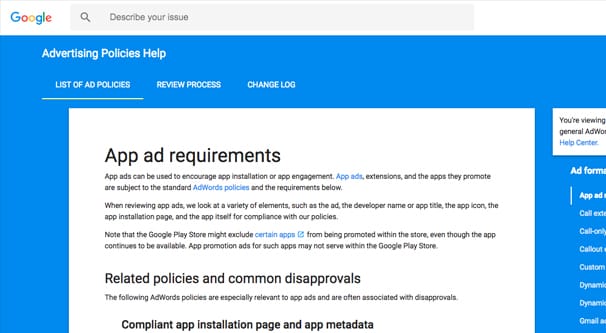
You may be tasked with keeping multiple versions of your app up to date and compliant with app restrictions. Since different devices might not be able to run different versions of an app, you’ll need to keep older versions alive in order to cater to all of the different devices Google might see.
Your app ads can be rejected if Google doesn’t like the destination of the ad, as well. For apps specifically this tends to mean an app ID that they don’t recognize, that they have removed or suspended in the past, or that isn’t the proper format. You can’t advertise an app that has been deleted or suspended, regardless of which storefront it was one.
Apps, of course, cannot advertise adult content any more than any other ad using AdWords. It doesn’t matter how well-designed your adult dating app is, you’ll need to find somewhere else to advertise it.
AdWords has an “unidentified business” policy, which means that any ad needs to showcase what business is doing the advertising, be it through branding of a URL or in the ad copy. Apps have to comply with this as well, by showing the name of the app at all times.
Image quality is also important for your app copy. You need to have sufficiently high resolution images, with no strobing, flashing, or otherwise detrimental imagery. If you’re using an HTML5 version of your app for a demo in-ad, you can have temporary strobe effects and so on, but only as triggered by user actions. In general, don’t try to be a dick with your attention-grabbing techniques.
One other quirk you might not think about is the unwanted software policy. Google has an entire policy about apps and software that might be in some way deceptive. Your apps cannot promise value they can’t provide, cannot trick users or piggyback on the installation of another app, hide significant features or functions of the app, affect the user’s device in a negative or unexpected way, collect user data without their permission, or be bundled without disclosure. It also cannot be difficult to remove in any way. You can read more about the specific definitions of each of those in the link I provided.
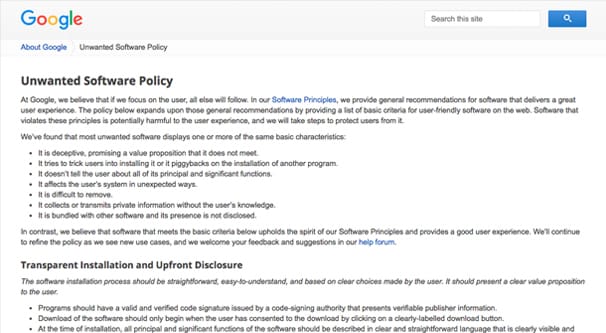
The other AdWords policies that are relevant to apps are all pretty sensible. Don’t infringe on any copyright or trademark, don’t promote malware, don’t use misleading or deceptive content, and so on.
Recommendations for Great App Ads
If you’re trying to advertise an app on either the iTunes store or the Google Play store, using AdWords as your platform, there are some best practices to dig into.
First of all, you’re going to want to set up conversion tracking, and you’re going to want to track more than just “did the user buy the app, y/n?” Track anything meaningful that you can use for metric improvements later on. For the most part, this just means adding the tracking code to your app and letting Google record the data you want to manage.
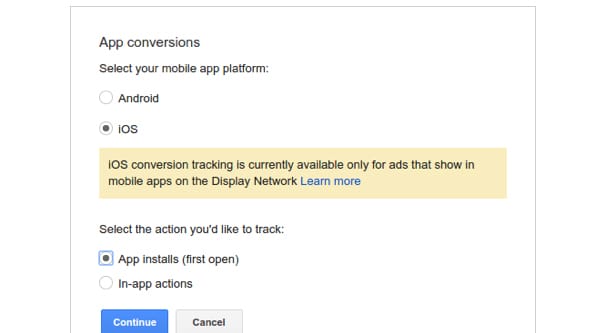
Google also recommends uploading a diverse range of assets for them to use with their app campaign system. The more assets you have and the more diverse they are, the better off you’ll be. Google will be able to more appropriately target specific kinds of copy to specific groups of users, instead of a one-size-for-all approach.
I strongly recommend using the Google universal app campaign function rather than trying to micromanage ads to other destinations. You end up losing some control, yes, but you save the time and energy you would spend in managing individual ads. The only detriment is that you don’t get the benefit of a landing page, you have to sell the app specifically based on your store page and preview video.
The exception to this is if you’re promoting an app that is relatively complicated and you want a full landing page to explain it. Even then, I recommend giving the universal campaigns a try. You never know; Google might be adept at promoting obtuse content. You can always change later if it doesn’t work properly.
The post Can You Promote a Mobile App Store Page on AdWords? appeared first on Growtraffic Blog.